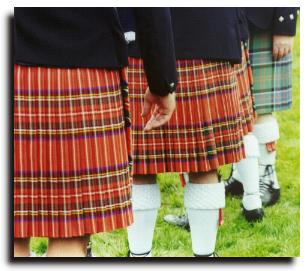
Did You Know?
- Tartans and the Kilt

As might be expected, tartans and the kilt have a great deal of myth and legend attached to them. The evolution of the kilt may have begun with the Scots from Ireland who adopted a version of the Roman tunica, a shirt which descended to the knee. It incorporated stripes (called "tarsna" in Irish Gaelic). Later, in medieval times, Scots fighting men, who could not afford metal armour, wore a quilted coat with heavy pleats which provided freedom of movement as well as some protection. It was not until the 16th century that the use of a simple length of cloth, belted round the waist, came into use. The "feileadh breacan" or "feileadh mor" (the big kilt) was several yards long and the Highlander had to lay it on the ground, gathering the cloth into pleats from the waist and with a length over his shoulder.
In 1581, George Buchanan described a multi-coloured, striped garment which appears to have been made of a kind of tartan cloth. However, although a particular local weaver may have had his own "sett" or pattern, at this stage there appears to have been no distinctive design for particular clans.
At the end of the 17th century, Martin Martin from Skye described how the patterns were formed from different thread patterns - the sequence laid down by numbers written on a piece of wood, which preserved continuity. But even by the time of the Jacobite Uprisings, it is thought that specific designs for individual clans had not evolved. And scraps of tartan which have come to us from ancient times bear little resemblance to those of today.
The banning of tartan after the 1745 Jacobite Uprising did not apply to Scottish Regiments. The first of these, the Black Watch, developed a distinctive tartan (which was, however, happily adopted by the Argyll and Sutherland Highlanders when they were first formed). But specific tartans for each new Scottish regiment soon evolved.

When prescription of tartan was repealed, there was an upsurge in its use, even by Lowland Scots. So when Sir Walter Scott stage-managed the visit of King George IV to Edinburgh in 1822, tartans, kilts and bagpipes burgeoned. A number of supposedly ancient manuscripts and pattern books were produced by manufacturers, defining which tartan was appropriate for each clan or surname. Border weavers and companies such as Wilsons of Bannockburn were only too pleased to meet (and encourage) the demand. The Sobieski Stewarts (brothers claiming to be grandsons of Prince Charles Edward) were in the forefront of this, but the book on which they based their claims for 75 clan tartans was never produced.Manufacturers have continued to add to the confusion with clans with dull tartans being given brighter "dress" patterns while those with bright colours have evolved duller "hunting" setts. As might be expected, there is controversy over when and how the present-day kilt - the "feileadh beg" or "little kilt" evolved, losing the upper length of cloth. The claim that an Englishman named Rawlinson in charge of an iron-smelting works in Lochaber introduced it as a way of reducing accidents, is disputed by many. But around the middle of the 18th century the small kilt with neater pleats and appearance became increasingly popular.
Clan chiefs were often called upon to decide what the clan tartan should be. There are also tartans for all sorts of purposes, from "district" tartans to "company" tartans, including the Scottish Parliament. There are now a number of organisations which claim to hold a register of "all known tartans".
Return to Index of "Did You Know?"
Where else would you like to go in Scotland?

